I have a similar problem as described in
EF can't infer return schema from Stored Procedure selecting from a #temp table
and I have created my stored procedure solution based on the solution described above BUT I am still getting a similar EF error and I really don't know why or understand how I can fix it.
A member of the type, 'rowNum', does not have a corresponding column in the data reader with the same name.
My specific error:
The data reader is incompatible with the specified 'TestModel.sp_SoInfoDocs_Result'. A member of the type, 'rowNum', does not have a corresponding column in the data reader with the same name.
My stored procedure:
ALTER PROCEDURE [dbo].[sp_SoInfoDocs]
@searchText nvarchar(200),
@PageNumber int,
@PageSize int
AS
BEGIN
IF 1 = 2
BEGIN
SELECT
cast(null as int ) as rowNum
,cast(null as text) as serverName
,cast(null as text) as jobName
,cast(null as DATETIME) as oDate
,cast(null as int) as runCount
,cast(null as nvarchar(10)) as orderID
,cast(null as text) as applicationName
,cast(null as text) as memberName
,cast(null as text) as nodeID
,cast(null as nvarchar(10)) as endStatus
,cast(null as int) as returnCode
,cast(null as DATETIME) as startTime
,cast(null as DATETIME) as endTime
,cast(null as nvarchar(50)) as status
,cast(null as text) as owner
,cast(null as bit) as existsNote
WHERE
1 = 2
END
DECLARE @LowerLimit int;
SET @LowerLimit = (@PageNumber - 1) * @PageSize;
DECLARE @UpperLimit int;
SET @UpperLimit = @PageNumber * @PageSize;
PRINT CAST (@LowerLimit as varchar)
PRINT CAST (@UpperLimit as varchar)
SELECT ROW_NUMBER() over (order by Expr1) as rowNum, *
into #temp
from (
SELECT dbo.SOInfo.jobName, dbo.SOInfo.nodeID, dbo.SOInfo.nodeGroup, dbo.SOInfo.endStatus, dbo.SOInfo.returnCode, dbo.SOInfo.startTime, dbo.SOInfo.endTime,
dbo.SOInfo.oDate, dbo.SOInfo.orderID, dbo.SOInfo.status, dbo.SOInfo.runCount, dbo.SOInfo.owner, dbo.SOInfo.cyclic, dbo.SOInfo.soInfoID, dbo.SOInfo.docInfoID,
dbo.SOInfo.existsNote, dbo.SOInfo.noSysout, dbo.serverInfo.serverName, dbo.Groups.label AS applicationName, Groups_1.label AS memberName,
Groups_2.label AS groupName, Groups_3.label AS scheduleTableName, dbo.SOInfo.serverInfoID, dbo.SOInfo.applicationID, dbo.SOInfo.groupID,
dbo.SOInfo.memberID, dbo.SOInfo.scheduleTableID, dbo.docFile.docFileID, dbo.docInfo.docInfoID AS Expr1, dbo.docFile.docFileObject
FROM dbo.SOInfo INNER JOIN
dbo.serverInfo ON dbo.SOInfo.serverInfoID = dbo.serverInfo.serverInfoID INNER JOIN
dbo.docInfo ON dbo.SOInfo.docInfoID = dbo.docInfo.docInfoID INNER JOIN
dbo.docFile ON dbo.docInfo.docFileID = dbo.docFile.docFileID LEFT OUTER JOIN
dbo.Groups AS Groups_3 ON dbo.SOInfo.scheduleTableID = Groups_3.ID LEFT OUTER JOIN
dbo.Groups AS Groups_1 ON dbo.SOInfo.memberID = Groups_1.ID LEFT OUTER JOIN
dbo.Groups AS Groups_2 ON dbo.SOInfo.groupID = Groups_2.ID LEFT OUTER JOIN
dbo.Groups ON dbo.SOInfo.applicationID = dbo.Groups.ID
WHERE CONTAINS (docfileObject,@searchText)
) tbl
SELECT Count(1) FROM #temp
SELECT rowNum, serverName, jobName ,oDate,runCount,orderID,applicationName,memberName,nodeID, endStatus, returnCode,startTime,endTime,status,owner,existsNote
FROM #temp WHERE rowNum > @LowerLimit AND rowNum <= @UpperLimit
END
My overall goals are:
search through clustered indexed table (docInfo) and find all rows that contain a specific search string value
at the same time capture metadata from other tables associated with each docInfo object
The results of actions (1) and (2) above are written to a #temp table to which I then add a rowNum column to enable me to introduce paging i.e.
introduce paging for the number of metadata results that can be returned at any one time, based on supplied PageNumber and PageSize variables.
What does work
I am able to successfully create the stored procedure.
Within SSMS I am able to successfully execute the stored procedure and it delivers the results I expect, here's an example
Within EF I have been able to update and import the stored procedure by updating from database
Within EF I am then able to see the Function Imports and can see the Mapping
Within ED I am then able to see the generated complex types
I use the following code to call the process
using (TestEntities context = new TestEntities()) { List<sp_SoInfoDocs_Result> lst = context.sp_SoInfoDocs(searchText, 1, 10).ToList(); }I compile and run my solution and get the following error from EF
'System.Data.Entity.Core.EntityCommandExecutionException' occurred in EntityFramework.SqlServer.dll
Additional information: The data reader is incompatible with the specified 'SysviewModel.sp_SoInfoDocs_Result'. A member of the type, 'rowNum', does not have a corresponding column in the data reader with the same name.
I am very much a novice / basic user when it comes to both SSMS / SQL and EF, this has stretched me as far as I understand / can go and I really don't know where to turn to next in order to resolve this problem.
I've searched extensively through SO and can see others who have had similar problems and have tried the solutions suggested but nothing seems to work for me.
I really would be very very grateful to anyone who could help me understand
what is it that is wrong / I've done wrong?
is there a better approach to achieve what I need?
ideas as to how I can fix this.
Thanks in advance





